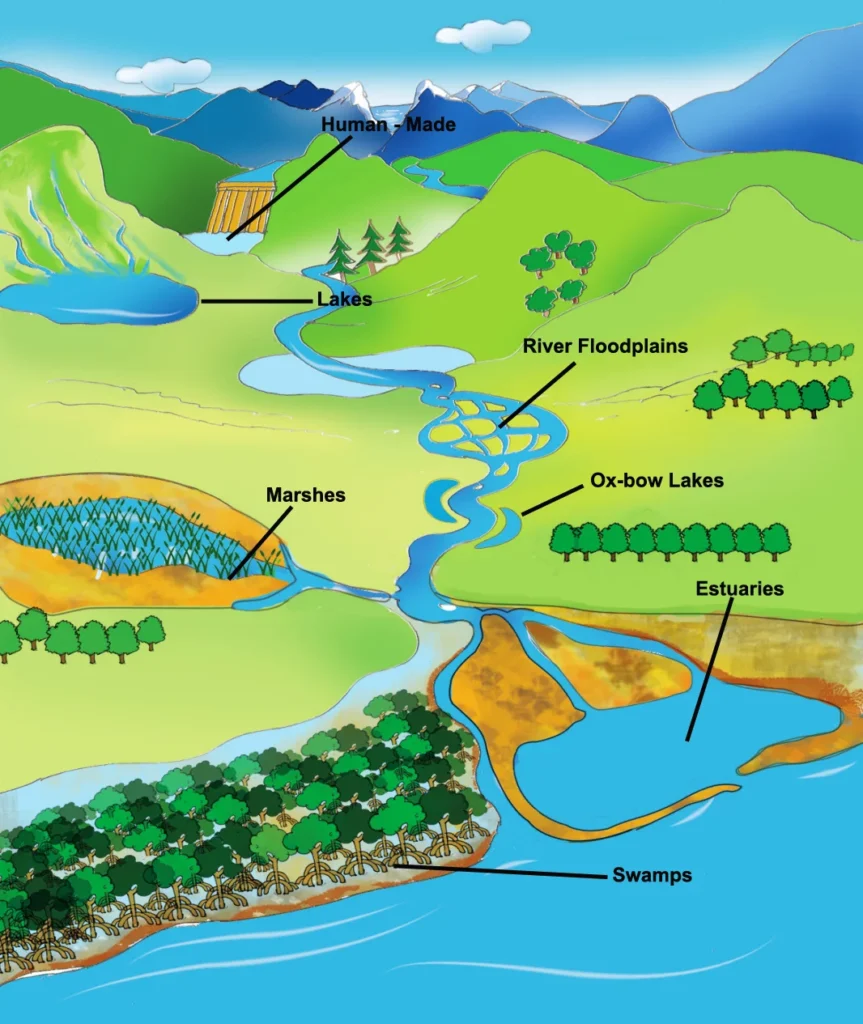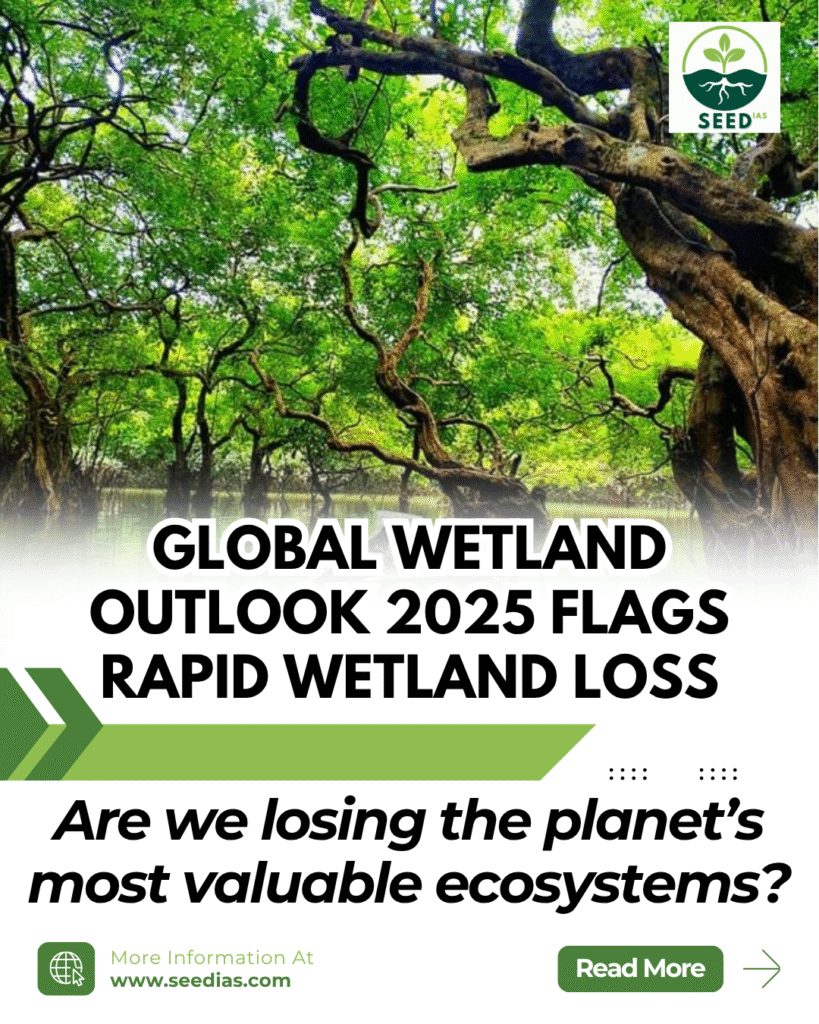Why in NEWS
The Global Wetland Outlook (GWO) 2025, released by the Ramsar Convention Secretariat, reveals that Africa has some of the most degraded wetlands globally and calls for urgent restoration and conservation aligned with global biodiversity and climate goals.
Key Terms and Concepts
| Term | Explanation |
|---|---|
| Ramsar Convention (1971) | Global treaty for the conservation and wise use of wetlands |
| GWO 2025 | Flagship global assessment of wetland health and trends |
| Kunming-Montreal Global Biodiversity Framework (KM-GBF) | Global biodiversity targets adopted in 2022 under the UN CBD |
| Nature-based Solutions (NbS) | Ecosystem-based strategies for addressing environmental challenges |
| Montreux Record | Ramsar list of threatened wetlands facing ecological damage |
Key Takeaways from Global Wetland Outlook 2025
| Theme | Details |
|---|---|
| Extent | Over 1,800 million hectares of wetlands globally, but data gaps persist |
| Loss | ~411 million hectares lost since 1970 (22% decline), with worst degradation in Africa, LDCs, and parts of Latin America and the Caribbean |
| Condition | Wetlands in LDCs are in the poorest health; developed countries fare better |
| Value | Wetlands provide ~USD 39 trillion in ecosystem services (~7.5% of global GDP) |
| Funding Gap | Biodiversity funding is only 0.25% of global GDP—insufficient for wetland needs |
| Urgent Needs | Restore 123–350 million hectares and effectively manage ~428 million hectares to meet KM-GBF Targets 2 and 3 |
Recommendations from GWO 2025
| Action | Explanation |
|---|---|
| Conserve Existing Wetlands | Cheaper than restoration; restoration costs USD 1,000–70,000 per hectare annually |
| Align with KM-GBF | Meet Target 2 (30% ecosystem restoration) and Target 3 (30% protection) |
| Invest in NbS | Wetlands as tools for disaster resilience, carbon storage, and water security |
| Scale Up Funding | Mobilize both public and private sector funds |
| Capacity Building | Create long-term strategies to protect and manage wetlands |
What are Wetlands?
| Category | Description |
|---|---|
| Definition (Ramsar) | Areas of marsh, fen, peatland, or water (natural/artificial, fresh/brackish/salty, permanent/temporary) |
| Types | Inland (lakes, rivers, marshes, oxbow lakes), Coastal (estuaries, mangroves, tidal flats), Human-made (dams, reservoirs, aquaculture ponds) |

Ecosystem Services of Wetlands
| Service | Details |
|---|---|
| Water Purification | Filters pollutants, improves water quality |
| Flood Control | Absorbs excess rainwater; reduces flood risks |
| Storm Protection | Mangroves and marshes reduce storm surges |
| Erosion Control | Roots of wetland vegetation stabilize soil |
| Biodiversity Habitat | Ecotones for amphibians, birds, fish, and mammals |
| Carbon Storage | Peatlands and mangroves sequester large amounts of CO₂ |
| High Productivity | Biomass output often exceeds that of agricultural crops |
| Education & Culture | Natural labs and cultural heritage zones |
Status of Wetlands in India
| Indicator | Detail |
|---|---|
| Wetland Count (2024) | 1,307 wetlands covering 1.35 million hectares |
| Ramsar Sites | 91 (latest: Khichan and Menar in Rajasthan, 2025) |
| Montreux Record Sites | 2 – Keoladeo National Park and Loktak Lake |
| Key Initiatives | Amrit Dharohar (eco-tourism & biodiversity), Wetlands of India Portal (2021), National Wetland Atlas, Integration with Namami Gange |
| Notable Wetlands | Chilika Lake (estuary), Kanwar Lake (oxbow), Sunderbans (mangrove), Bakhira and Kanwar Jheel (floodplains) |
In a Nutshell
Mnemonic: “WET-VITAL”
Wetlands cover vast ecosystems—coastal, inland, man-made
Ecosystem services valued at USD 39 trillion
Twenty-two percent lost since 1970
Very poor condition in LDCs
Invest in NbS, not just restoration
Target 2 & 3 under KM-GBF must be met
Africa, Latin America worst hit
Learn from India’s Ramsar push & Amrit Dharohar
Prelims Practice Questions
- Which of the following is not a type of wetland under the Ramsar Convention?
A. Coral reefs
B. Desert dunes
C. Oxbow lakes
D. Salt marshes - Which of the following pairs is correctly matched?
A. Montreux Record – List of wetlands protected from hunting
B. Wetlands of India Portal – Launched in 2015
C. Kanwar Lake – Asia’s largest freshwater oxbow lake
D. GWO – Released by UNEP - Wetlands deliver about how much of the global GDP value, as per GWO 2025?
A. 1.5%
B. 3.0%
C. 7.5%
D. 15.0%
Mains Questions
- Wetlands are vital for ecosystem health, climate regulation, and economic stability. Discuss the findings of the Global Wetland Outlook 2025 in this context. (15M)
- Wetland restoration is essential but expensive. Examine India’s current efforts and suggest measures to bridge the funding and policy gaps. (10M)
Answer Key with Explanations
| Qn | Answer | Explanation |
|---|---|---|
| 1 | B | Desert dunes are not considered wetlands under Ramsar |
| 2 | C | Kanwar Lake in Bihar is Asia’s largest oxbow lake |
| 3 | C | Wetlands deliver approximately 7.5% of global GDP value |
















